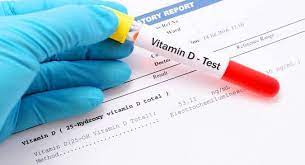Unveiling the Hidden Signs: Symptoms of Vitamin D Deficiency
What Are The Symptoms Of Vitamin D Deficiency? Symptoms include fatigue, bone and muscle pain, weakened immune system, mood swings, hair loss, slow wound healing, and increased risk of chronic diseases. Proper testing, treatment, and prevention are vital for maintaining optimal health.

Introduction
In the realm of health and wellness, one nutrient often flies under the radar but plays a crucial role in our overall well-being: vitamin D. Despite its significance, vitamin D deficiency is a widespread issue affecting people worldwide. This blog post aims to shed light on the symptoms of vitamin D deficiency, helping you recognize the signs and take proactive steps towards better health.
Understanding Vitamin D
Vitamin D, often referred to as the “sunshine vitamin,” is a unique nutrient that your body can produce when exposed to sunlight. It also exists in some foods and can be obtained through supplements. This essential vitamin plays a vital role in various bodily functions, including bone health, immune system support, and mood regulation.
Vitamin D Deficiency: An Underdiagnosed Epidemic
Vitamin D deficiency is more common than you might think. Studies indicate that a significant portion of the global population lacks adequate vitamin D levels. Certain factors, such as limited sun exposure, dark skin, obesity, and age, can increase the risk of deficiency. Recognizing the prevalence of this issue is the first step towards addressing it effectively.
Common Symptoms of Vitamin D Deficiency
-
Fatigue and low energy levels
- Feeling excessively tired, even after getting sufficient rest
- Lacking motivation and struggling to engage in daily activities
-
Bone and joint pain
- Experiencing chronic pain in the bones and joints
- Suffering from frequent fractures or weakened bone structure
-
Muscle weakness and difficulty in physical performance
- Feeling weak and finding it challenging to perform physical tasks
- Experiencing muscle cramps or spasms
-
Frequent illness and weakened immune system
- Falling ill more often, especially with respiratory infections
- Prolonged recovery periods and compromised immune responses
-
Depression and mood swings
- Experiencing persistent feelings of sadness, anxiety, or irritability
- Mood fluctuations and decreased enjoyment in activities
-
Hair loss and brittle nails
- Noticing increased hair shedding or thinning
- Having weak and easily breakable nails
-
Slow wound healing
- Delayed healing of cuts, bruises, or surgical incisions
- Increased susceptibility to infections
-
Cognitive impairment and brain fog
- Difficulty concentrating or focusing on tasks
- Memory problems and reduced cognitive function
-
Restless sleep and insomnia
- Trouble falling asleep or staying asleep throughout the night
- Restlessness and frequent waking up
-
Increased risk of chronic diseases
- Higher susceptibility to conditions like osteoporosis, heart disease, and autoimmune disorders
- Compromised overall health and well-being
Exploring the Link between Vitamin D Deficiency and Specific Conditions

-
Osteoporosis and bone health
- The crucial role of vitamin D in calcium absorption and bone density
- Long-term deficiency leading to osteoporosis and increased fracture risk
-
Rickets in children
- Insufficient vitamin D causing soft and weak bones in growing children
- Deformities and growth abnormalities associated with rickets
-
Seasonal affective disorder (SAD)
- The connection between vitamin D levels and mood regulation
- Low sunlight exposure during winter leading to vitamin D deficiency and SAD symptoms
-
Autoimmune diseases
- Research suggesting a correlation between vitamin D deficiency and autoimmune conditions like multiple sclerosis, rheumatoid arthritis, and lupus
- Potential benefits of vitamin D supplementation in managing symptoms
-
Cardiovascular diseases
- Vitamin D’s role in maintaining heart health and preventing cardiovascular diseases
- Association between low vitamin D levels and increased risk of heart attacks, strokes, and hypertension
-
Diabetes
- Links between vitamin D deficiency and type 1 and type 2 diabetes
- The potential role of vitamin D in improving insulin sensitivity and blood glucose control
-
Cancer
- Emerging evidence on the relationship between vitamin D deficiency and various types of cancer, including breast, colon, and prostate cancer
- Further research needed to determine the exact mechanisms involved
The Importance of Getting Enough Vitamin D
Maintaining optimal vitamin D levels is crucial for overall health and well-being. Some key benefits include:
-
Promoting calcium absorption and bone health
- Ensuring strong bones and preventing osteoporosis
- Reducing the risk of fractures and bone-related diseases
-
Supporting immune system function
- Enhancing the body’s ability to fight infections and diseases
- Reducing the likelihood of developing autoimmune conditions
-
Regulating mood and mental health
- Aiding in the production of serotonin, a neurotransmitter that influences mood
- Reducing the risk of depression, anxiety, and seasonal affective disorder
-
Preventing chronic diseases
- Lowering the risk of developing conditions such as heart disease, diabetes, and certain types of cancer
- Supporting overall health and longevity
Testing and Treating Vitamin D Deficiency

-
Recommended tests for diagnosing vitamin D deficiency
- Blood tests to measure the levels of vitamin D in the body
- Understanding the optimal range and interpreting the results
-
Treatment options: sunlight exposure, dietary changes, and supplementation
- Safe sun exposure guidelines to stimulate vitamin D production
- Incorporating vitamin D-rich foods into the diet, such as fatty fish, fortified dairy products, and eggs
- Supplementation with vitamin D3, under medical supervision, if necessary
-
Guideline for daily vitamin D intake
- Recommended daily allowances of vitamin D according to age and health conditions
- Discussing the appropriate dosage with a healthcare professional
Prevention and Lifestyle Tips for Maintaining Vitamin D Levels
-
Safe sun exposure guidelines
- Balancing sun protection and vitamin D synthesis
- Identifying the optimal time and duration for sun exposure based on geographic location and skin type
-
Dietary sources rich in vitamin D
- Incorporating foods like fatty fish, mushrooms, fortified dairy products, and egg yolks into your diet
- Exploring dietary supplements as a complementary source
-
Incorporating physical activity into daily routine
- Engaging in outdoor activities and exercises that promote sunlight exposure
- Combining regular exercise with vitamin D production
-
Strategies for at-risk groups
- Pregnant women: Ensuring adequate vitamin D levels for both maternal and fetal health
- Older adults: Considering supplements due to reduced ability to synthesize vitamin D from sunlight
Consultation with Healthcare Professionals
Healthcare providers play a critical role in diagnosing and treating vitamin D deficiency. It is essential to consult with a medical professional if you experience persistent symptoms or suspect a deficiency. They can guide you through appropriate testing, personalized treatment plans, and ongoing monitoring.
What Happens When Your Vitamin D is Low?
What Are the Five Signs You May Have Vitamin D Deficiency?
There are several signs that may indicate a vitamin D deficiency. If you experience any of the following symptoms, it is worth considering the possibility of inadequate vitamin D levels in your body:
- Fatigue: Feeling excessively tired and lacking energy, even after getting enough rest.
- Bone and Muscle Pain: Chronic pain in the bones and joints, along with muscle weakness and difficulty in physical performance.
- Frequent Illness: Increased susceptibility to infections, frequent bouts of respiratory illnesses, and a weakened immune system.
- Mood Swings: Persistent feelings of sadness, anxiety, irritability, or fluctuating moods.
- Hair Loss: Experiencing increased hair shedding or thinning, along with brittle nails.
If you notice these signs, consulting with a healthcare professional and getting your vitamin D levels tested is recommended. Proper diagnosis, treatment, and prevention strategies can help restore optimal vitamin D levels and improve your overall health and well-being.
How Can I Raise My Vitamin D Level Quickly?
If you’re looking to raise your vitamin D levels quickly, there are several strategies you can implement. Here are some effective ways to boost your vitamin D:
- Sun exposure: Spend time outdoors and expose your skin to sunlight, especially during midday when the sun’s rays are strongest. Aim for 10-30 minutes of sun exposure on your arms, legs, or face, depending on your skin type and sensitivity.
- Dietary sources: Incorporate foods rich in vitamin D into your diet. Fatty fish like salmon, mackerel, and sardines are excellent sources. Other options include fortified dairy products, eggs, and mushrooms.
- Supplementation: Consider taking vitamin D supplements, especially if you have limited sun exposure or have difficulty obtaining sufficient vitamin D through diet alone. Consult with a healthcare professional to determine the appropriate dosage for your specific needs.
- Get active: Engage in regular physical activity, as exercise has been shown to increase vitamin D levels. Combine outdoor exercises, such as walking, jogging, or hiking, with sunlight exposure for an added benefit.
- Consult a healthcare professional: If you suspect vitamin D deficiency or have specific health concerns, it is recommended to seek guidance from a healthcare professional. They can assess your vitamin D levels through blood tests and provide personalized advice on supplementation and lifestyle adjustments.
Remember, while raising your vitamin D levels quickly is possible, it’s essential to maintain a balanced approach and prioritize your overall health and well-being.
What Blocks Vitamin D Absorption?
What Diseases Can Cause Low Vitamin D?
Low vitamin D levels can be caused by various diseases and conditions, including:
- Malabsorption disorders: Conditions such as celiac disease, Crohn’s disease, and inflammatory bowel disease can impair the absorption of dietary vitamin D in the intestines, leading to low levels.
- Liver diseases: Liver disorders, including cirrhosis and nonalcoholic fatty liver disease, can affect the conversion of vitamin D into its active form, leading to insufficient levels.
- Kidney diseases: Chronic kidney disease and other kidney disorders can disrupt the conversion of vitamin D into its active form and impair its proper utilization, resulting in low levels.
- Hyperparathyroidism: Overactive parathyroid glands can cause increased breakdown of vitamin D, leading to deficiency.
- Pancreatic insufficiency: Conditions such as chronic pancreatitis and pancreatic cancer can impact the production of pancreatic enzymes necessary for vitamin D absorption.
- Obesity: Excess body weight can contribute to lower vitamin D levels due to increased sequestration of the vitamin in adipose tissue.
- Certain medications: Some medications, such as glucocorticoids, anticonvulsants, and antiretrovirals, can interfere with vitamin D metabolism and decrease its levels in the body.
- Chronic inflammatory conditions: Diseases like rheumatoid arthritis, systemic lupus erythematosus, and psoriasis can cause chronic inflammation, which can reduce vitamin D levels.
- Aging: As individuals age, their skin becomes less efficient at converting sunlight into vitamin D, making older adults more susceptible to deficiency.
- Certain cancers: Some cancers, including breast, colon, and prostate cancer, have been associated with lower vitamin D levels, although the exact mechanisms are still being studied.
It’s important to note that while these conditions can contribute to low vitamin D levels, they are not the sole causes. Proper diagnosis and treatment of these underlying diseases, along with addressing vitamin D deficiency, are essential for optimal health.
What Are The Symptoms Of Vitamin D Deficiency Conclusion
Understanding the symptoms of vitamin D deficiency is crucial for maintaining optimal health and wellness. By recognizing these signs, you can take proactive steps to address deficiencies and promote overall well-being. Remember, a healthy lifestyle, balanced diet, safe sun exposure, and consultation with healthcare professionals are key in maintaining adequate vitamin D levels and reaping the benefits it offers.
By prioritizing your vitamin D levels, you embark on a journey towards a healthier and more vibrant life.